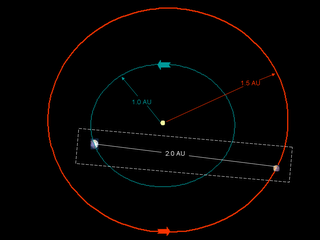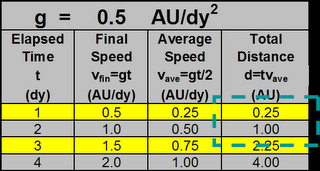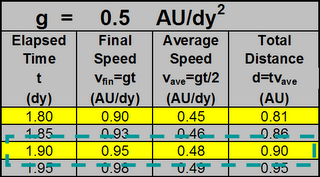Transfer Orbits
If time aplenty is on your hands;
then, a simple transfer will do.
If you're not in any hurry;
then, you don't need any fuel.
Mankind currently orbits to other planets.
It takes no fuel, but it takes a while.
G-force propulsion will be much quicker.
It will take some fuel.
It takes no fuel, but it takes a while.
G-force propulsion will be much quicker.
It will take some fuel.

| |||||||||||||||||||||||||||||||||||||||||||||||||||||||||||||
|---|---|---|---|---|---|---|---|---|---|---|---|---|---|---|---|---|---|---|---|---|---|---|---|---|---|---|---|---|---|---|---|---|---|---|---|---|---|---|---|---|---|---|---|---|---|---|---|---|---|---|---|---|---|---|---|---|---|---|---|---|---|
G
| = |
6.67428 × 1011 m3/(kg-sec2)
|
|---|---|---|
M☉
| = |
1.98892 × 1030 kg
|
μ☉
| = |
G × M☉
|
μ☉
| = |
6.67428 ×1011 m3 /(kg-sec2)×1.9889 × 1030 kg
|
μ☉
| = |
1.32746 × 1020 m3 /sec2 = 39.49 AU3/yr2
|
√(μ☉)
| = |
1.15 × 1010 √(m3) /sec = 6.28 √(AU3)/yr
|
Hohmann Transfer (HT) is a special case TO; it is considered to be the most fuel efficient. TE uses HT model to conveniently compute some typical TO durations. Furthermore, TE uses some assumptions to further simplify this process. These are discussed later in this chapter.
TE settles on HT for "typical transfer times". For more on orbits and on HTs, see book, Orbital Motions, by A. E. Roy.
Table 2: Typical TO Distances
Axis
tricity
Axis
Time
Axis
Distance
**Earth
1 AU
D E P A R T U R E O R B I T
Mars
1.52 AU
0.21
1.26 AU
1.23 AU
3.91AU
Jupiter
5.2 AU
0.63
3.10 AU
2.41 AU
8.72 AU
Saturn
9.51 AU
0.81
5.26 AU
3.08 AU
13.53 AU
Uranus
19.18 AU
0.9
10.09 AU
4.40 AU
24.45 AU
Neptune
30.06 AU
0.94
15.53 AU
5.30 AU
36.45 AU
Kuiper Belt
40 AU
0.95
20.50 AU
6.40 AU
47.71 AU
aD+1
2
2
π√(aτ2 + bτ2)
√2
- **Assume ships depart Earth's orbit with radius of 1 AU.
- Semimajor axis, aD, of destination orbit is observed.
- TO eccentricity [eTO = (aD-1)/(aD+1)] per formula (12.3) on page 355, Orbital Motion by A. E. Roy.
- Transfer Orbit (TO) is the highly elliptical orbit which connects orbit of Earth with orbit of destination planet.
- TO period is the time needed for space vessel to depart orbit of Earth, go to orbit of destination planet; then, return to orbit of Earth.
- Of course, only half this time is needed to transit from Earth orbit to destination orbit (Transfer Time).
- TO semimajor axis, [aTO = (aD+1)/2] is average of Earth's a (1.0 AU) and aD, destination semimajor axis.
- TO semiminor axis, bTO , is computed via a common elliptical identity.
- Transfer distance (dTO) is approximated by one half of TO elliptical circumference (CTO ≈ 2 * π * √((aTO2+bTO2)/2).)
| Destination | Transfer Orbit | |||||||||||||||||||
|---|---|---|---|---|---|---|---|---|---|---|---|---|---|---|---|---|---|---|---|---|
| Semi-Major Axis | Period | Circum | Aphelion | Perihelion | Min Velocity | Ave Velocity | Max Velocity | |||||||||||||
| aD | P | CT | QT | qT |
vmin
| vave | vmax | |||||||||||||
| Earth | 1 AU | 3.16x107 sec | 9.40x108 km | 1 AU | 1 AU |
29.81 k/s
| 29.8 k/s |
29.81 k/s
| ||||||||||||
| Mars | 1.52 AU | 4.47x107 sec | 1.17x109 km | 1.52 AU | 1 AU |
21.54 k/s
| 26.24 k/s |
32.75 k/s
| ||||||||||||
| Jupiter | 5.2 AU | 1.73x108 sec | 2.61x109 km | 5.2 AU | 1 AU |
7.43 k/s
| 15.15 k/s |
38.61 k/s
| ||||||||||||
| Saturn | 9.51 AU | 3.81x108 sec | 4.05x109 km | 9.51 AU | 1 AU |
4.22 k/s
| 10.65 k/s |
40.11 k/s
| ||||||||||||
| Uranus | 19.18 AU | 1.01x109 sec | 7.32x109 km | 19.18 AU | 1 AU |
2.14 k/s
| 7.23 k/s |
41.11 k/s
| ||||||||||||
| Neptune | 30.06 AU | 1.93x109 sec | 1.09x1010 km | 30.06 AU | 1 AU |
1.38 k/s
| 5.65 k/s |
41.48 k/s
| ||||||||||||
| Kuiper Belt | 40 AU | 2.93x109 sec | 1.43x1010 km | 40 AU | 1 AU |
1.04 k/s
| 4.87 k/s |
41.65 k/s
| ||||||||||||
| Observed | 2π√(aT3) √μ | 2π√(aT2+bT2) √2 | aT + cT | aT - cT |
| CT P |
| |||||||||||||
| vτ = | √[μ☉( |
2
rτ | - |
1
aτ | )] |
|---|
μ☉
| = |
132,712,440,018 km3/sec2
|
|---|
| μ☉ | = |
132,712,440,018 km3
sec2 | × |
AU
149,597,870.7 km |
|---|
| μ☉ | = |
887.128 km2
sec2 | × |
AU
|
|---|
| √μ☉ | = |
29.785 km
sec | × |
√AU
|
|---|
| vτ = 29.785 km/sec × | √[AU( |
2
rτ | - |
1
aτ | )] |
|---|
| vτ ≈ 30 kps × | √[ |
2
rτ | - |
1
aτ | ] |
|---|
Minimum Velocity happens at TO's farthest point from Sun (aphelion, Qτ).
Each TO aphelion is semi-major axis of destination orbit (aDest).
| vτ ≈ 30 kps × | √[ |
2
Qτ | - |
1
aτ | ] |
|---|
| vτ ≈ 30 kps × | √[ |
2
qτ | - |
1
aτ | ] |
|---|
| vτ ≈ 30 kps × | √[ |
2
| - |
1
aτ | ] |
|---|










0 Comments:
Post a Comment
<< Home